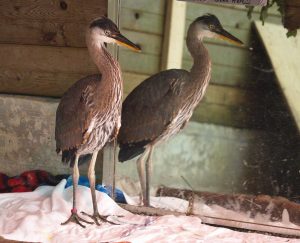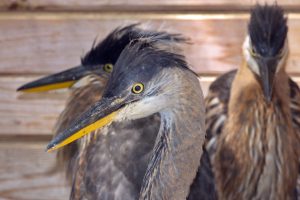Support Us
Since 1979 more than 140,000 animals have been treated by Wildlife Rescue.
Thanks to the support of individuals like you, Wildlife Rescue can provide a lifeline for animals in distress.
Great Blue Herons are a familiar sight on British Columbia’s coast with wide wings, long “S” shaped necks, and grey-blue feathers. Their remarkably still stance in water, the plumes on their heads, and the black line above their eyes make them distinctive from any other bird.
Last year, Wildlife Support Centre received a call from a frantic man who witnessed a large tree with 3 visible Great Blue Heron nests tragically falling. The soil was unstable due to trees currently being cut down at the top of the hill. This impact on the tree also struck neighbouring trees on the way down, causing deadly damage to MANY NESTS.

This Great Blue Heron rookery (nesting area) is on Tsawwassen First Nations land. Wildlife Support Centre staff jumped into action by first contacting the Resource Coordinator for Tsawwassen First Nations to offer support by sending a Response Team to assist with the rescue of injured herons and assess the circumstances. Rescue volunteers and First Nations Resource Coordinator joined up at the rookery very quickly. They found over a dozen fledglings dead and 6 in critical condition, rushing them to the Wildlife Rescue hospital.
These babies were unable to make the jump or take flight when the trees fell. There were a couple of fledglings who were probably already on the ground that were healthy, in good condition, and able to make their way to safety.
The living babies received a thorough examination that indicated severe pelvic fractures, wrist fractures, destroyed vision, inability to walk or stand, central nervous system trauma, and severely low blood markers. This intense impact caused extensive fractures and internal damage that growing babies cannot survive.
Unfortunately, only two of the six fledglings made it through this tragic occurrence and were under hospital care until they were ready to return to the wild.
Great Blue Herons typically reside in habitats with access to salt or freshwater (such as coasts, rivers, marshes, and lakes) and grasslands. They use their long necks and beaks to grab their food and gulp it whole. Males make the nests made of sticks, to attract females (they choose new partners every year through complex courting methods). She will pad it with softer materials such as moss and grass. These nests can be found in trees high off the ground and will house 2 to 6 eggs, light blue in colour. These herons typically breed from February to May in groups called colonies (also known as heronries) in British Columbia. Many migrate south to avoid our cold winters.

While Great Blue Herons are protected by the Migratory Bird Act, they still face many threats. The young herons saved by Wildlife Rescue in this tragedy are just a small example of this. British Columbia’s continual deforestation has led to fewer nesting spots for all species. The tree that toppled over recently had weak roots due to recent deforestation. By chopping down trees the soil is disrupted, leading to unbalanced trees. Nesting colonies are often destroyed by humans logging, driving motorboats, or other interruptions allowing predators an opportunity to grab their eggs. Lastly, water quality is important for these birds. Great Blue Herons often wade through water to find their food, so pollutants such as chemicals can not only poison what they eat but contaminate their bodies.
While these threats are dangerous, there are many things we can do to help Great Blue Herons survive. Keeping healthy trees in place is an excellent way to guarantee that herons have enough nesting spots. We can make sure that these herons are not driven away from their young by steering clear of Great Blue Heron nests to avoid disrupting them. Using natural herbicides and pesticides for our lawns and other outdoor areas (specifically near streams) instead of chemicals will help Great Blue Herons survive.
Of course, rescuing herons in need is another way to help. If you see a bird that has exposed bone or blood, bugs or insects covering it, no feathers, or a bird that is sleeping, human intervention may be required. Please contact our Support Centre for assistance.
The recent events in Tsawwassen are grave, and there is still much we can do to make sure these incredible birds stay safe. By leaving trees, avoiding nests, and using environmentally friendly products, Great Blue Herons will be a little bit safer.
Help these fledglings return safely to the wild!